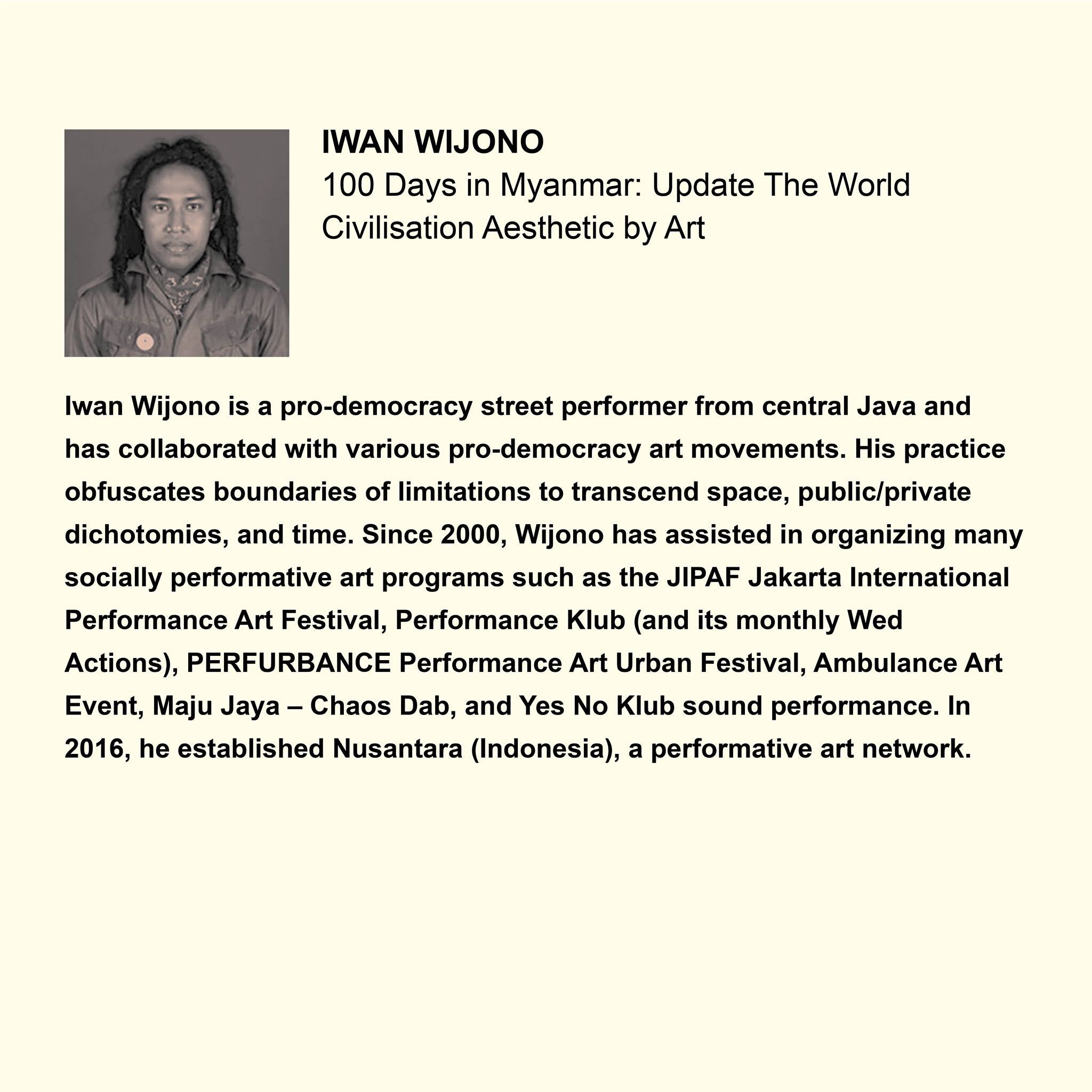ART AND DEMOCRATIC STRUGGLE IN MYANMAR: 100 DAYS AFTER THE COUP










TRANSNATIONAL COALITION FOR THE ARTS, in collaboration with ARTS OF THE WORKING CLASS, will host “Art and Democratic Struggle in Myanmar: 100 Days After the Coup” to acknowledge 100 days of Myanmar under the military junta on May 11. This conference will discuss the Myanmar military’s attack on democracy and human rights, as well as the importance of artist-led activism and next actions. Talks by artists and cultural workers of Myanmar and the Global South feature ANONYMOUS YANGON-BASED ARTIST, CHAW EI THEIN, NATHALIE JOHNSTON, IWAN WIJONO, SATADRU SOVAN BANDURI, DAISUKE TAKEYA, and ANTONIO LA VIÑA, moderated by MARV RECINTO. A roundtable among panelists and an open forum with the public will follow.
On 1 February 2021, the day before the Parliament of Myanmar intended to swear in elected officials, the Myanmar military (officially known as the Tatmadaw) seized political power from the democratically elected National League for Democracy (NLD) in a violent coup d’état and plunged the country into a year-long state of emergency and martial law. The Tatmadaw annulled the NLD’s landslide victory over the military-backed Union Solidarity and Development Party (USDP) in the November 2020 election on the unsubstantiated basis of electoral fraud,[1] subsequently transferring executive power to Commander-in-Chief Senior General Ming Aung Hlaing and deposing President Win Myint, State Counsellor of Myanmar Aung San Suu Kyi, as well as other senior members of the NLD.
The people of Myanmar have condemned the Tatmadaw’s assault on democracy, staging widespread peaceful protests and acts of civil disobedience known locally as the Spring Revolution. Artists and cultural workers are among those at the forefront of these demonstrations, creating anti-military protest visuals, performance art, video, and photography. The nature of these mediums is both permanent and ephemeral; as files, they can be hidden and transported easily for wider (and lasting) dissemination. Social media has also functioned as an archive and space for solidarity, with posts coalescing under hashtags like #WhatIsHappeningInMyanmar, #MyanmarNow, or #YouMessedWithTheWrongGeneration.[2]
The junta’s violent reaction has resulted in 759 murders and 3,485 detained as of 30 April.[3] To further stifle community organization and dissent, the Tatmadaw has conducted internet, media, and social media blackouts while also targeting journalists and spreading disinformation.
Today’s crisis builds upon Myanmar’s long history of successive, brutal military dictatorships that have augmented economic instability and racial tensions.[4] From 1962 to 2010, Myanmar remained under junta control and met each political revolt with brute force; the international community demonstrated their disapproval with sanctions that ultimately affected the impoverished the most.
It was only in 2011 that the military-backed government began to implement reforms that many hoped would lead the country to stability and democracy, and indeed the country’s last two elections in 2016 and 2020 seemed to promise a new era of unprecedented political freedom. However, the looming grasps of the USPD and Tatmadaw were never far away: Ming Aung Hlaing has instructed the military’s ongoing genocide and exodus of the Rohingya Muslims since 2016; Military defector Major Hein Thaw Oo told Radio Free Asia that he anticipated plans for a coup as early as 2015.[5]
Returning to the present day, the international community, including the United Nations, have already denounced the junta as an illegitimate government, but is this enough? The Association of Southeast Asian Nations (ASEAN) recently hosted an emergency summit with respective leaders and Ming Aung Hlaing, despite the protest of Burmese people, effectively acknowledging the junta as a legitimate government. Days after, the Tatmadaw issued a statement effectively ignoring ASEAN’s five consensus points. Myanmar is on the brink of collapsing into a failed state, yet political experts caution that the Tatmadaw will not concede to civilian protests and international pressure. Therefore, with “Art and Democratic Struggle in Myanmar: 100 Days After the Coup,” we will show what art can do.
1.The NLD won over 60% of the vote, and there has been no evidence of voter fraud. However, it is certainly worth mentioning that over a million people, including Rohingya Muslim refugees, were denied the right to vote and polls in several constituencies with large ethnic minorities were canceled. See Thant Myint-U, ‘What next for Burma?’, London Review of Books (blog), 18 March 2021, https://www.lrb.co.uk/blog/2021/march/what-next-for-burma.
2. GenZ, having lived in Myanmar with relative freedom and internet fluency, are largely leading protests.
3. Assistance Association for Political Prisoners, ‘Daily Briefing in Relation to the Military Coup: 30 April 2021’, 30 April 2021, https://aappb.org/?p=14745.
4. See Thant Myint-U, The Hidden History of Burma: A Crisis of Race and Capitalism, 2021.
Major Hein Thaw Oo, Interview: ‘Military Leaders Are Afraid of Letting Their Power Go’, 20 April 2021, https://www.rfa.org/.../hein-thaw-oo-04202021170420.html.
Text by Marv Recinto.
May 11, 2021
2:30PM Yangon
3:00PM Bangkok
4:00PM Manila
5:00PM Tokyo
9:00AM London
10:00AM Berlin
live on Transnational Coalition for the Arts
#SolidarityWithMyanmar
#StopArrestingArtists
#StopKillingActivists
#FreeMyanmarNow
See Less